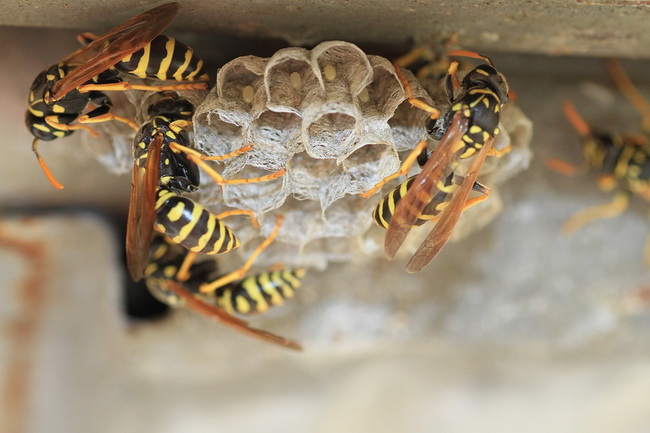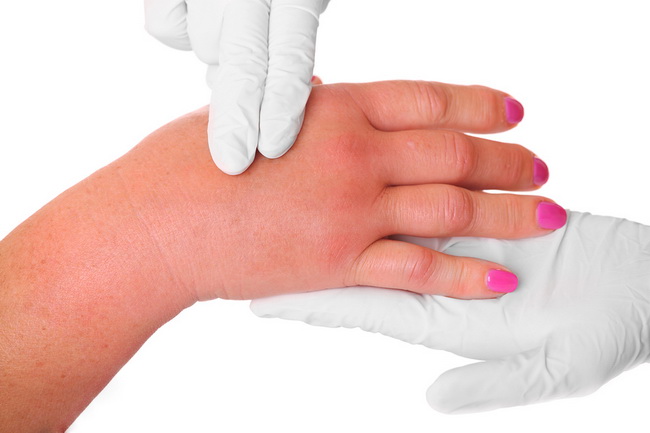- Make It Yourself Lavender Heart-Shaped Bath Bombs!
- 20 Things You Never Knew About “Down There”
- 12 Best Foods For Those Suffering From Arthritis Pain
- 12 Personal Hygiene Mistakes Almost Everyone Makes (Mom Never Told You About #4!)
- 15 Medicinal Plants And Herbs From The Cherokee People
- 12 Mind-Blowing Benefits Of Drinking Coconut Water During Pregnancy
- 12 Outstanding Winter Foods That Won’t Fatten You Up Like A Christmas Turkey
Completely Natural Ways to Get Rid of Wasps and Treat Stings

Photo credit: bigstock.com
Spring has sprung, friends, and that means more time outdoors, picnics, parties, working in the garden, watching the kids play outside. It also means more stinging insects like wasps. Although wasps are actually good for the environment, they pollinate plants and eat other insects, but too many wasps can be a problem. Unlike honeybees that can only sting once, then die, wasps can sting again and again, which is not only painful, but can be downright dangerous if you or someone in your family is allergic to their stings.
An occasional wasp is one thing, but once they make a nest, that is something most people find intolerable in their yard. There are many ways to get rid of wasps or stop them from making your yard their home. One of them is to buy one of those long reaching poisons. Those should be your absolute last resort as they spread over a fairly wide area and can kill bees, butterflies, or anything else small that the spray reaches.
There are plenty of natural ways to keep wasps out of your yard and outsmart them at their own game. Once you understand a bit about how wasps work, and what attracts them, you will find that keeping them out of your neck of the woods is easier than you thought.
Keep reading. We not only have some great ways to outsmart those wasps, but natural ways to treat those stings if you should get too closely acquainted!
1. Prevention
Prevention now, in the early spring, can go a long way towards trying to deal with a bigger problem later in the summer.
- In spring and the early summer, wasps are looking for protein. Normally this would be grasshoppers or ants but the leftovers of your summer picnic, cat food, or open garbage containers will all do just fine. Wasps imprint on their food sources, which means that once they find food, they will keep coming back to that area in hopes of a repeat performance again and again. Remove or cover all food sources and trash cans.
- By mid-summer through fall, wasp’s food preferences change to the sweet side. They also become more aggressive looking for those sweets. So clean up fruit that has fallen to the ground underneath trees, cover open soda cans or juice containers, and don’t leave the trash uncovered.
- Seal entry points around your home or in out buildings. If you see single wasps close to your house, follow it (at a safe distance) and see if it is building a nest in an entry point. Sealing common nesting locations, such as door frames, dampers, cracks around windows, unsealed vents, and cracked wood, such as porch covers or eves.
- Don’t wear bright colors or floral patterns. Wasps like flowers, too, and if you look like a giant flower, they might find you more interesting than you find them! Avoid perfume as well. A sweet smell means food to a wasp.
- Don’t Swat or Squish wasps! Although that might be your first reaction, when you swat or squish a wasp, it releases pheromone, a chemical that actually attracts wasps and gets them excited. Just walk away from an annoying wasp and it should go away.
- Paint your house blue! Or at least paint underneath the eves of the house or other areas where wasps tend to make nests. Wasps won’t build nests on blue paint.
Continue to Page 2

Photo credit: bigstock.com
2. Wasps Enjoying Your Bird House?
For some reason, wasps seem to enjoy building their nests in birdhouses. You can avoid this by simply lining the inside of the roof with some aluminum foil (you can easily attach it with a staple gun) or rubbing the underside of the roof, inside and outside, with some Ivory soap. Wasps don’t like the smell of soap or the sound that aluminum foil makes. One application of soap should last an entire season and the birds won’t mind it. Another remedy, as we mentioned above, is to paint the underside of your bird house, inside and out, a sky blue color. For some reason, wasps and mud daubers will not build a nest on blue paint – go figure!
SEE ALSO: How to Repel Ticks Naturally and Prevent Lyme Disease
3. Soap Sprays
Speaking of soap, you can always make up a safe spray made with some simple dishwashing soap and water. Using one of those garden hose type sprayers, spray the nest or circling wasps from a safe distance. This will kill the wasps and remove the nest while you stay safe. This works great at dusk, when wasps are less active and much less aggressive.
Continue to Page 3

Photo credit: bigstock.com
4. Natural Wasp Deterring Plants
Like most insects, there are some plants and trees that wasps simply do not like the smell of. This would include mint, citronella, wormwood, and eucalyptus. Plant these around your home will naturally keep wasps from sticking around for long. You can also put small potted plants on your patio tables or bouquets with eucalyptus to help keep wasps away from your picnic.
5. Traps
If you still have a problem, you can always use simple traps to place around your home. There are plenty of instructions online for making simple wasp traps, or you can buy a ready-made one that comes with bait at just about any garden or home improvement store. Most traps are made of glass or plastic with a small hole in the bottom that the wasp flies into, attracted by some really stinky bait, but when they try to escape, they will fly up and find the container is sealed. Some traps drown the wasp in a small amount of liquid, or they simply die in the container after a few days. Traps work best when they are hung about 4 feet off the ground, where most wasps hunt for food.
YOU MIGHT ALSO LIKE: Bloodsuckers Spreading a New Deadly Virus in the U.S.
6. Fake Them Out
Wasps are extremely territorial creatures and they won’t make a nest in another wasp’s territory. Putting up some fake nests around your home and yard will stop them from building nest of their own in what they think is another wasps stomping grounds. You can buy plastic nests at most garden stores or make your own. Again, you will find tutorials online to make your own fake wasp nest. Place the nests about 25 feet apart and wasps should steer clear. You know, when you can’t beat ‘em, join ‘em!
Continue to Page 4

Photo credit: bigstock.com
If you should get stung by a wasp, there are plenty of home remedies that can help stop the itching, the burning, and the pain.
- Wash the wound with water to help remove some of the venom, and then apply a cotton ball that has been soaked in white vinegar to the sting. Leave on the sting until no more pain is felt.
- Alternately, if someone has a cigarette or pipe tobacco, break open the cigarette and moisten some of the tobacco with some water, until it makes a paste. Apply to the sting and hold in place using a cloth or bandage until the pain and swelling is gone. The tobacco will draw out the venom.
- You can also use baking soda and water and use the same way you would the tobacco. When you see a yellow spot in the baking soda, you will know that the venom has been drawn out. This method is also excellent for bees, yellow jackets, and non-poisonous stings from scorpions.
- Another old remedy is to cut an onion in half and rub the cut part gently over the sting site.
If you have an allergy to wasp stings, always seek medical attention immediately, as this could be life threatening!
Wasp stings can sometimes cause a bacterial infection. If your sting site remains hot, red, swollen, or inflamed 8 hours afterwards and does not appear to be improving, seek medical attention.
References:

































